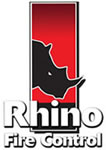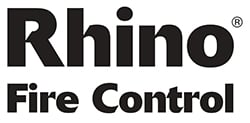Fire Suppression Systems
Design | Installation | Maintenance
At Rhino Fire Control, we specialise in designing, installing, and maintaining cost-effective fire suppression systems. Our solutions are easy to install and aim to eliminate the risk of extensive and destructive fires, thereby preventing significant financial losses for your business.
Our fire suppression systems protect valuable assets such as computer equipment, stock, and machinery, while also safeguarding employees, customers, and visitors.
With low installation and maintenance costs, our systems offer high versatility, allowing them to be installed in any room or equipment enclosure. In the event of a fire, our advanced systems ensure reduced downtime and limited damage to key components, keeping your business operational and secure.
What is a Fire Suppression System and How Do They Work?
Fires are unpredictable, often occurring in the most unexpected places and at the most unexpected times. When designing a fire safety strategy, it’s easy to focus on high-risk areas within your premises and concentrate fire alarms, extinguishers, and sprinklers in these locations. Consequently, ‘cold spots’ may remain where alarms fail to detect an outbreak of fire, and extinguishers do little to fight back the flames.
Fire suppression systems are invaluable in areas particularly exposed to fire risk, such as commercial kitchens, where high temperatures and oils can accelerate the spread of a fire. There are several types of fire suppression systems used to quickly put out fires in affected areas:
By implementing the appropriate type of fire suppression system, you can ensure comprehensive fire safety coverage and protect your valuable assets, employees, customers, and visitors from the devastating effects of fire.
Legal Requirements before a fire suppression system installation
Room Integrity Tests: A room integrity test is required by UK building regulations before you install a gas fire suppression system. This test must be conducted at least once per year and whenever changes are made to the protected space. The test uses controlled airflow to measure the leakage rate in the room, ensuring that fire suppression gases are adequately contained. A test must be carried out to ISO-14520 and NFPA-2001 (National Fire Protection Association) standards for each room using gas fire retardants. Please contact us for more information.
Specialist Fire Suppression Systems
Server Room Fire Suppression
Server rooms and data centres require an automated fire suppression system that can detect and quickly suppress a fire before it causes severe damage. Our server room fire suppression systems are compatible with clean air environments and use regulation-compliant inert gas or chemical suppression agents.
Commercial Kitchen Fire Suppression
Commercial kitchens present a variety of fire hazards, including gas pipes, electrical equipment, and cooking oils. Standard suppression strategies could exacerbate a blaze—for instance, ceiling-mounted water sprinklers on a fat fire could cause an explosion. Kitchens often have environmental triggers such as steam, intense heat, smoke, and naked flames that are normal but would activate a fire suppression system in other contexts. Therefore, kitchens require a specific type of fire suppression system tailored to their unique hazards. Our kitchen fire suppression systems are designed to quickly detect unexpected fires and apply a targeted wet chemical agent to suppress the fire and prevent it from spreading. These systems are modular and can be adapted to commercial kitchens of any size. Please see our kitchen suppression systems page for more details.
Fire Suppression for Electrical Cabinets, Machinery, Engine Bays, and Forklifts
We also design specialist fire suppression systems for small enclosures and micro-environments containing vulnerable machinery or equipment where an electrical fire is more likely, such as electronic control cabinets or CNC machines. These systems feature a pressurized tube that, if melted by intense heat, automatically releases a gas suppressant, such as carbon dioxide or foam. The suppressant starves the fire of the oxygen it needs, quickly cooling and quenching the flames. Direct suppression releases the suppressant over a target area directly from the tube, while indirect suppression disperses it via valves over a wider area.
By understanding and implementing the correct type of fire suppression system, you can protect your valuable assets, employees, and premises from the devastating effects of fire. Contact us to learn more about our fire suppression solutions tailored to your specific needs.
Frequently Asked Questions
Have Question? We are here to help
What are the benefits of a fire suppression system?
The benefits of a fire suppression system include a safer and more productive working place. Lower insurance premiums but above all confidence that you have effective fire protection for your business. If you would like to read more visit our PAFSS LPS166 page.
Can you fit a kitchen fire suppression system?
Yes we can and we can tailor it to the size of your kitchen. Commercial kitchens are a high risk area for fire but a kitchen fire suppression solution can reduce the number of accidents in your business. Read more here.
Food manufacturers are losing millions due to false alarms how can a fire suppression solution help?
The financial implications of downtime in the food manufacturing industry cannot be overstated. According to research, manufacturers lose approximately £180bn every year as a result of downtime, with every minute of stalled production translating to lost revenue, increased labour costs, and penalties for failing to meet supply obligations. Unlike equipment breakdown, which can often be quickly resolved, the downtime that arises from a fire can stretch from hours to days or even weeks, depending on the extent of the damage and the time required for repairs and inspections. The cumulative impact of such disruptions can amount to millions in lost income and damage to brand reputation.
How often should a room integrity test be performed?
Room Integrity Tests should be conducted at least once a year as a part of regular maintenance. Additionally, any construction work that may affect the air tightness of the room, such as drilling holes or installing cables, pipes, or ducts, should trigger a retest: this could result in alterations to the structure of the building that could allow suppression gas to escape. Read more here.
How often should our fire suppression system be tested?
Like all firefighting measures, you need to be confident that a fire suppression system will activate quickly if a blaze is detected. Accidental triggering of the system causes inconvenience and disrupts operations, while a slow response to a real fire could cause extensive damage and put lives in danger.
A fire suppression system inspection and maintenance service will determine if the system is in optimum operating condition. By identifying emerging problems, such as blocked hoses or corroded cylinders, immediate action can be taken to address the issues before they impede performance during an emergency.
While the law doesn’t stipulate how often fire suppression systems should be inspected, food manufacturing facilities are required to ensure their systems are maintained so they are safe, efficient, and reliable. As a rule of thumb, you should adhere to the following maintenance schedules:
- Water Sprinklers: inspection should take place every 6 months.
- Gas Suppression Systems: these should be inspected at least twice a year due to the increased risks associated with this type of system. An annual room integrity test should also be carried out to ensure the room is sealed correctly.
During the inspection, every component within a fire suppression system should be meticulously checked and evaluated by a qualified, independent third-party specialist.
What is the difference between a fire suppression system and a fire sprinkler system?
A fire sprinkler system is a series of interconnected sprinklers that release high pressure water in the event that a blaze is detected. Water simultaneously lowers the temperature of a fire and smothers it of oxygen, ending the combustion cycle. This enables a fire to be extinguished or controlled until fire and rescue personnel arrive.
Fire suppression systems release the substance when a fire is detected, for example if excessive heat or smoke occur in a room. The substance may be released as a fine mist which helps to quell the fire by starving it of oxygen. Integration with other fire control measures, such as alarm systems, give occupants of the building ample warning of the fire and allows them to evacuate quickly.


